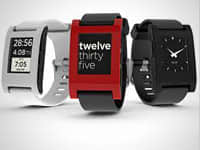US start-up Pebble raises $10 million on Kickstarter – StartupSmart
A California-based start-up called Pebble has smashed its goal of raising $100,000 on crowdfunding platform Kickstarter, raising more than $10 million, with seven days still to go.
Led by Eric Migicovksy, Pebble has developed a customiseable e-paper watch, allowing users to download watch faces, use sports and fitness apps, and receive notifications from their phone.
Pebble used Kickstarter in a bid to raise $100,000, but has already raised more than $10 million from almost 67,000 backers, despite the fact there are still seven days left to make a pledge.
“We think the ability to create and use apps is one of Pebble’s most exciting features,” Pebble spokesperson Andrew Witte wrote in a company blog post.
“Drawing on our experience with our previous generation inPulse smartwatch, we’re designing Pebble from the ground up with third party apps in mind.”
Witte said the company wants to ensure Pebble apps can easily communicate with smartphone apps as well as the internet and cloud-based services.
“So we’ll be creating iOS and Android libraries that enable smartphone developers to push data to a companion Pebble app for display on the user’s wrist, as well as allowing Pebble to remotely control smartphone apps,” he wrote.
“We’ll allow Pebble to send data to a web service via Bluetooth and the smartphone’s internet connection.”
“We’ll provide a web service so that web app developers can send notifications to Pebble without having to write a single line of code for either the smartphone or the watch itself.”
According to Ryan Wardell, founder of Sydney-based crowdfunding site Project PowerUp, Pebble “pretty much nailed everything” with regard to its Kickstarter campaign.
“The video itself is more of a product demonstration – it’s not just someone talking to the camera. They’re just showing off the watch and what it can do,” Wardell says.
Wardell also points out that Pebble had a finished product before it went on the Kickstarter platform, and used a pricing structure that incentivised people to contribute a larger amount.
For example, if someone pledged $115, they would receive a black Pebble watch. But if they pledged just $10 more, they would receive a Pebble watch in any colour.
“It’s also not their first product, so they would have built up a bit of a customer database,” he says.
Wardell says while the Kickstarter platform is incredibly attractive among cash-strapped start-ups, it tends to produce better results for physical products.
“If someone has a website or a service business, and can’t show the product and what it can do, they could struggle to attract money,” he says.
According to Wardell, there are three main “circles” of people who are likely to contribute funds.
“Your friends and family give you money because they like you. The next circle is people who believe in the idea and see the great vision,” he says.
“The third group is people who are giving you money because they want to buy something.”
“Pebble nailed the first and second group super quickly, which allowed time to capitalise on the third circle.”

